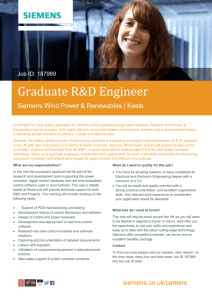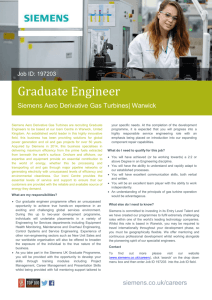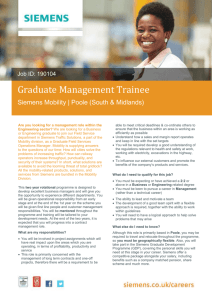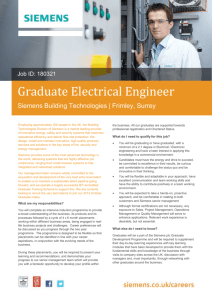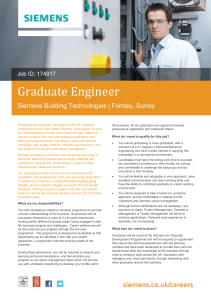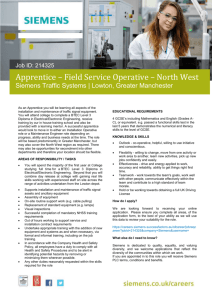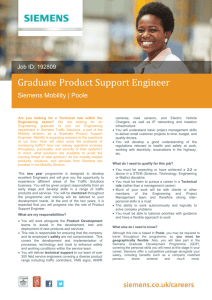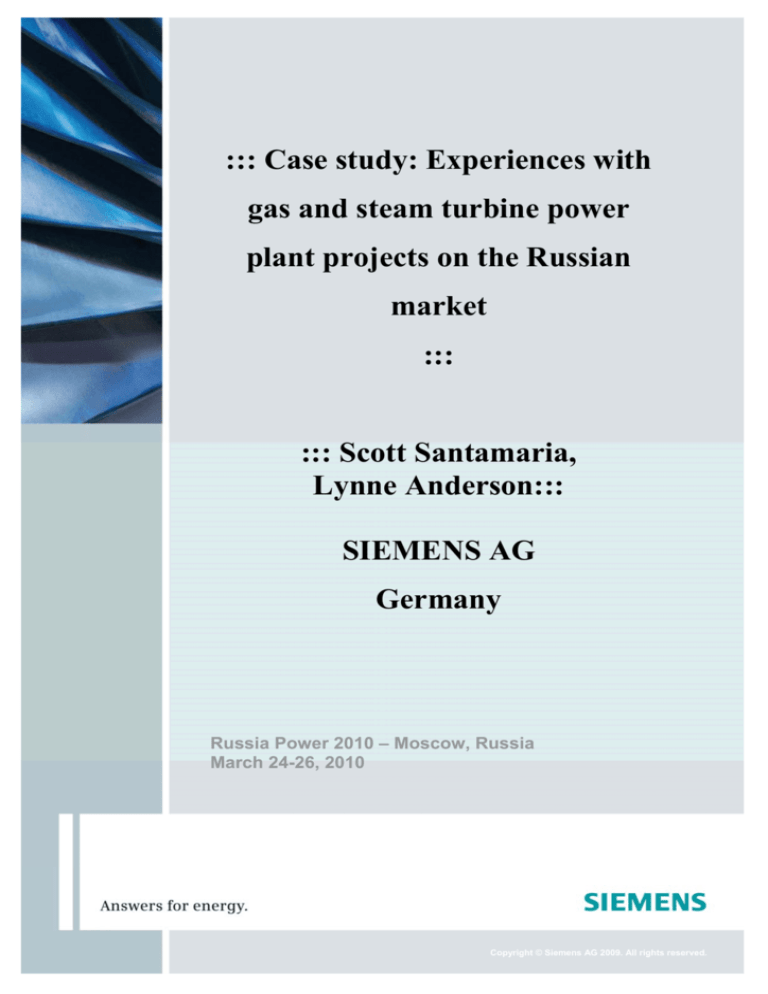
::: Case study: Experiences with
gas and steam turbine power
plant projects on the Russian
market
:::
::: Scott Santamaria,
Lynne Anderson:::
SIEMENS AG
Germany
Russia Power 2010 – Moscow, Russia
March 24-26, 2010
1
Copyright © Siemens AG 2009. All rights reserved.
Copyright © Siemens AG 2009. All rights reserved.
Abstract
Looking back in time a few years ago to the booming power generation market, one has seen
the Russian electricity demand grow alongside high oil prices and the increasing industry
investments. This strong growth, together with aging capacity, has created a need for new
investments. Experts estimate that Russia will need an additional capacity of approximately
180GW of electricity generation by 2020, which is almost the equivalent of its installed
capacity. The challenge is not only to attract enough capital, but also simply to carry out these
huge investment projects as scheduled, ensuring the availability of equipment, engineering
and management resources.
Siemens has unique experience as a supplier of key components for gas and steam turbine
power plant projects on the Russian market. Since 2001, 29 Siemens SGT-800 gas turbines
alone (presently rated at 47MW) have been ordered by customers from Russia, for
implementation in different types of power plant, either as single machines or as part of a
more complex plant solution. The Moscow City 226-MW combined-cycle power plant was
the first plant to be built and is our showcase reference in Russia. The Strogino combinedcycle urban power plant, which has two generator units, each with a capacity of 130MW, is
another plant that has been equipped with both gas and steam turbines from Siemens. In June
2009, the Kolomenskoe gas turbine power plant in Moscow, supplied with three SGT-800
units, started up commercial operation. These are just a few examples of Siemens success
with supply of turbines to the Russian market, and the main references in this paper.
This paper will not only cover and explain technical features with case studies of these
projects, but also share Siemens’ unique expertise and experiences as a key component and
power plant supplier on the Russian market. The primary focus of these projects will be
power plants based on the SGT-800 gas turbine, the most powerful of the Siemens industrial
gas turbines, including where applicable Siemens steam turbines and other Siemens
equipment/expertise.
Copyright © Siemens AG 2009. All rights reserved.
2
Moscow City Power Plant
Combined-cycle power plant with cogeneration
Fig. 1, Moscow City Power Plant II
Moscow City is an ongoing project creating an International Business Center in the center of
Moscow, Russia. The entire project is scheduled to be completed by the year 2020, and for the
purposes of effective construction, the project is subdivided into several separate smaller
projects, including skyscraper office blocks, restaurants, retail outlets, parks, hotels and
residences for approximately one and a half million inhabitants. The underground area of the
complex houses a parking lot and a “mini-metro” station is also connected to Vnukovo and
Sheremetyevo airports via a high-speed transport system.
Copyright © Siemens AG 2009. All rights reserved.
3
To power this gigantic complex, Siemens has earlier signed two separate turnkey contacts for
a 226-MW combined-cycle power plant with cogeneration. The plant consists of two
combined-cycle blocks, type SCC-800 2 x 1. Each block is based on two 45-MW SGT-800
gas turbines (the standard at that time) and one 30-MW SST-700 steam turbine, all supplied
from the Siemens industrial turbine facility in Finspong, Sweden. The plant provides district
heating and power to the new international business center, a complex covering 30 million sq.
ft on a 100 hectare site.
Both phases of the Moscow City Power Plant are now in operation, with phase II being the
first to come into commercial operation in September 2007 (Phase 1 during the summer of
2009). Each phase (I & II) is a 110-MW combined-cycle power plant, including two 45-MW
combustion gas turbines (SGT-800) fired with natural gas, two heat recovery steam generators
(HRSG´s), one district heating condensing 30 MW steam turbine (SST-700), one peak waterheating boiler and auxiliary systems. The peak water-heating boilers were designed and
constructed by JSC “Drogobuzkotlomash” of Russia.
Hot exhaust gases from the gas turbines generate steam of two pressures in the HRSG. These
high pressure and low-pressure steam flows are produced by the HRSG at superheated
conditions and fed to the steam turbine, which is connected to a two-stage district heating
condenser system. A summer cooler is installed to cater for operation cases when heating
water requirements are low. See diagram below.
Fig 2, CHP Principle diagram
Copyright © Siemens AG 2009. All rights reserved.
4
Strogino (phase I & II)
Combined-cycle power plant with cogeneration for district heating
Strogino is the second power plant based on the SGT-800 gas turbine to be commissioned in
Russia. Strogino, also located in Moscow, is also a two-phase design, the first phase having
been commissioned in March of 2009. Siemens’ customer in this case is the Moscow Unified
Power Company Municipality (Moscow Government), which is a spearhead project in the
Moscow Power Program. Siemens is installing the plant in cooperation with Elektrozavod,
with each phase of the scope including 2 x SGT-800 gas turbines, 1 x SST-400 41.2 MW
steam turbine, gas boosters, gas receiving units and instrument air compressors. This plant is
also a combined-cycle power plant with cogeneration for district heating, the most efficient
and economical form of generation with minimal heat losses.
Fig. 3, SGT-800 in workshop
Kolomenskoe
Cogeneration plant with district heating.
Another power plant that started commercial operation in 2009 is the Kolomenskoe
cogeneration plant that generates electricity and district heating for the city of Moscow. The
Kolomenskoe gas turbine power plant is part of the Moscow government’s power generation
Copyright © Siemens AG 2009. All rights reserved.
5
program to supply high-efficiency, eco-friendly heat and power to Moscow. It will generate
136 MW of electricity and 171 Gcal per hour of district heat and operate with an overall plant
efficiency of approximately 83 percent.
The end customer and sole investor for the project, for which Siemens supplied the three
SGT-800 gas turbines, the instrumentation and control system as well as site services, is
NaftaSib Energia, which is part of NaftaSib group. The Siemens scope of supply also includes
site service, including supervision of the installation, commissioning and training of the
customer personnel. Siemens also delivered the instrumentation and control system SPPAT3000 to further enhance the flexibility and environmental friendliness of the power plant.
Site service is provided by the Russian organization of Siemens Energy. With its very low
NOx emissions, the advanced SGT-800 gas turbine supports eco-friendly, highly efficient
power generation in the heart of the Russian capital. Thanks to the successful cooperation
between NaftaSib Energia and Siemens, the project was completed exactly within the
scheduled time frame of two years.
The Moscow government professed itself very pleased with the Kolomenskoe power plant
project. As of today, it is the only one of eight projects within the program of construction,
which has been implemented on time despite the world economic crises, even though some of
the projects started earlier. It is the first time in Russian power generation history that a
power plant has been built at a noise level of 41 decibels, the current Russian sanitary norm
being 85 decibels. These results lead to the possibility of building such power plants even in
the housing zone.
Tuapse - cogeneration of electricity and steam
One of the most recent contracts signed by Siemens Energy is once again with the Russian oil
and gas company Rosneft. The order is for the delivery of six SGT-800 industrial gas turbines
with an output of 47 megawatts each. The gas turbines will be used for generating electricity
and steam to accommodate the expansion of the Rosneft refinery in Tuapse, an important
petroleum port where the Grozny-Tuapse oil pipeline ends at the Black Sea. The crude oil
processed there is oil produced in Western Siberia and Southern Russia and transported via
Transneft’s pipeline system and by rail.
Copyright © Siemens AG 2009. All rights reserved.
6
Commissioned in 1929, Tuapse Refinery is Rosneft’s oldest refinery. Located in Russia’s
Krasnodar region, the refinery, with a capacity of roughly 5 million tones per year, is the only
such facility on that seacoast. Its product mix primarily consists of gasoline, naphtha, diesel
and fuel oil. Located adjacent to an oil-loading terminal, the refinery exports approximately
90% of its products. Rosneft is now seeking to more than double the refinery’s capacity to
increase its depth from 56 to 95%, by implementing a major expansion and upgrade.
The six power generating units include the 100th SGT-800 unit to be produced since its
introduction. A critical project requirement for the gas turbines being supplied to the Tuapse
refinery is low NOX emissions during operation while using various fuels. The SGT-800 can
burn a wide range of fuels of varying quality and subsequent initiatives have been taken to
increase the gas turbine’s fuel flexibility still further. The first three gas turbines will be
delivered by October 2010, with the remaining three units to follow in October 2012.
These projects illustrate some of the versatility of the Siemens installed equipment in Russia,
from isolated equipment to full turnkey. Other installations of interest are, for example, Perm
TEC-6, a Siemens power-island installation based on 2xSGT-800 and 1xSST-600, and
Priobskoe (phase I, II, & III): This component sale of 7xSGT-800 represents the first Siemens
oil and gas reference in Russia, the customer again being Rosneft.
The SGT-700 gas turbine has also been a strong seller on the Russian market, in both power
generation and mechanical drive applications. Sochi, on the Black Sea coast, is the site of the
first two SGT-700 power generation sets delivered to Russia. The SGT-700’s are installed in
the recent 76-MW combined heat and power plant, which provides power generation and
district heating for the town of Sochi. Since this is one of Russia's major resorts on the Black
Sea Coast there are high demands on the environmental impact of the plant and, of course, the
demand for uninterrupted power supply, which SGT-700 fulfils. The plant is crucial for the
area’s power supply, especially in the winter period, which means that availability and
reliability are extremely important to the customer. To ensure continuous operation the units
are therefore equipped with dual-fuel technology (liquid fuel operation as back-up).
About our components *
*As supplied to the projects defined in this paper.
The reason for the particular popularity of the SGT-800 is that it is designed specifically for
power generation and cogeneration, and has a very high efficiency in combined cycle. It is the
Copyright © Siemens AG 2009. All rights reserved.
7
largest of the Siemens industrial gas turbine range (5 to 47 MW) and the obvious choice
where there is a need for a constant and reliable power supply. At 31.2 MW electrical output,
the SGT-700 is a smaller but versatile mid-range machine, adapted for both power generation
and mechanical drive. It shares the same combustion technology as the SGT-800, both of
them meeting stringent emissions requirements with dual-fuel DLE technology without need
for complicated control systems or water injection.
The SGT-800 gas turbine is an industrial gas turbine of modular design. It is of single-shaft
design, driving the electric generator through a parallel shaft reduction gear. The gas turbine
is mounted on a steel base frame with an integral oil tank and other auxiliaries. The package is
based on a single-fuel gas turbine, fired by natural gas and including a dry low NOx
combustion system. A sound enclosure is located over the gas turbine and gearbox to ensure
85 dBA external noise limits at 1 metre. The enclosure is fitted with ventilation units, gas
detection and fire suppression systems, and access ways for personnel during maintenance.
Combustion air is cleaned through a three-stage static type of intake filter. An anti-icing
system and silencer are located at the air intake duct.
When equipment is to be supplied in combined cycle, Siemens has a range of steam turbines
which can be matched to its gas turbines, to provide the ideal solution for the customer.
The SST-700 steam turbine, as supplied to the Moscow City power plants, is a multi-stage
district-heating condensing turbine. The steam turbine and its electric generator are mounted
directly on the turbine's concrete foundation.
The steam turbine lube-oil reservoir is placed beside the steam-turbine gearbox and the AC
generator. An accessible sound enclosure is located over the gear to ensure required noise
levels are adhered to.
The water/steam circuit consists of a heat recovery steam generator (HRSG) which generates
steam by extracting heat from the exhaust gas flow of the gas turbine. The HRSG is designed
as a dual-pressure, natural circulation boiler comprising:
•
Stack with silencer
•
Low Pressure (LP) Economizer
•
LP Evaporator with steam drum
•
LP Superheater
•
High Pressure (HP) Economizer
Copyright © Siemens AG 2009. All rights reserved.
8
•
HP Evaporator with steam drum
•
HP Superheater
The layout concept represents an optimal utilization for the site conditions. The advantages of
this concept are:
•
Short connections between all major plant components (piping and cables) resulting in
reduced energy losses.
•
Short distances providing for easy operation and maintenance.
•
Adequate separation between the power train and the balance of plant components to
facilitate maintenance.
The smaller SST-400 steam turbine, as supplied to the Strogino plant, has also been refined
to fit combined cycle applications. The SST-400 product line was designed and developed to
meet current market trends and requirements by the use of standardized sets of components
with high flexibility for adaptation to project-specific requirements, e.g. bleeds, extractions,
second admission typical for double-pressure HRSG’s of combined cycles, etc. The sustained
demand to reduce investment cost of steam turbines for industrial applications over the last 20
years has led to introduction of the concept of a gearbox between the steam turbine and the
generator for generator-drive steam turbines in the power range up to 60 MW.
One positive economic side effect of this development is the potential to reduce the rotation
speed of the generator to half synchronous speed and thus use a four-pole generator, which is
cheaper than a two-pole machine. The concept of a four-pole generator and an appropriate
gearbox, together with the well-optimized standard components, forms the basis for a “kitset”
design. The degree of standardization and effective production methods ensure economically
effective solutions.
The blade path uses reaction blading, which, from the efficiency point of view, is less
sensitive to operation off the optimum or guaranteed load point. That brings a significant
advantage and the benefit of decreased fuel consumption for plants.
The turboset concept allows for a modern axial exhaust layout, if preferred. This brings the
customer the benefit of cost reduction in terms of civil works. The turbine is mounted on a
Copyright © Siemens AG 2009. All rights reserved.
9
skid, the generator is anchored to the concrete foundation and the gearbox in between is
mounted on an oil tank which integrates the active parts of the oil system into a single central
package, thus minimizing the risk of oil leakage. This turbine is highly flexible in operation: it
has been proven successful in combined-cycle power-plant (CCPP) applications, not only
together with Siemens gas turbines but also with gas turbines of other brands.
Figure no.4 – “kitset” design of the Siemens’ SST-400 condensing steam turbine
Conclusion
Russia continues to be faced by the challenge of financing and timely execution of huge
investment projects to provide sustainable and reliable energy for its residential and industrial
areas, ensuring the availability of equipment, engineering and management resources. Singlesource supply of equipment and solutions is of great benefit to the customer since this ensures
compatibility of equipment, facilitates repeatability and simplifies supply and project
management. Over the last few years Siemens has shown that it has the versatility and
competence to provide specific customer solutions with selected components from its rich
product portfolio, reinforced by its global resources. Siemens continues to invest in research
and development to further refine its products – efficiency, fuel flexibility and environmental
capabilities in gas turbines to meet market and customer demands are some prime examples
of this continued development. Some of these refinements have already been implemented in
the equipment described in this paper: more precise details will be given in the verbal
presentation.
Copyright © Siemens AG 2009. All rights reserved.
10
Permission for use
The content of this paper is copyrighted by Siemens and is licensed to PennWell for
publication and distribution only. Any inquiries regarding permission to use the content of
this paper, in whole or in part, for any purpose must be addressed to Siemens directly.
Disclaimer
These documents contain forward-looking statements and information – that is, statements
related to future, not past, events. These statements may be identified either orally or in
writing by words as “expects”, “anticipates”, “intends”, “plans”, “believes”, “seeks”,
“estimates”, “will” or words of similar meaning. Such statements are based on our current
expectations and certain assumptions, and are, therefore, subject to certain risks and
uncertainties. A variety of factors, many of which are beyond Siemens’ control, affect its
operations, performance, business strategy and results and could cause the actual results,
performance or achievements of Siemens worldwide to be materially different from any
future results, performance or achievements that may be expressed or implied by such
forward-looking statements. For us, particular uncertainties arise, among others, from changes
in general economic and business conditions, changes in currency exchange rates and interest
rates, introduction of competing products or technologies by other companies, lack of
acceptance of new products or services by customers targeted by Siemens worldwide, changes
in business strategy and various other factors. More detailed information about certain of
these factors is contained in Siemens’ filings with the SEC, which are available on the
Siemens website, www.siemens.com and on the SEC’s website, www.sec.gov. Should one or
more of these risks or uncertainties materialize, or should underlying assumptions prove
incorrect, actual results may vary materially from those described in the relevant forwardlooking statement as anticipated, believed, estimated, expected, intended, planned or
projected. Siemens does not intend or assume any obligation to update or revise these
forward-looking statements in light of developments which differ from those anticipated.
Trademarks mentioned in these documents are the property of Siemens AG, its affiliates or
their respective owners.
Copyright © Siemens AG 2009. All rights reserved.
11


